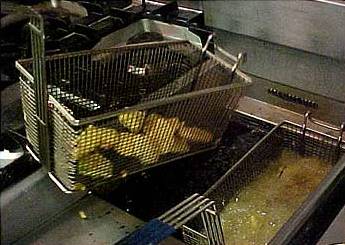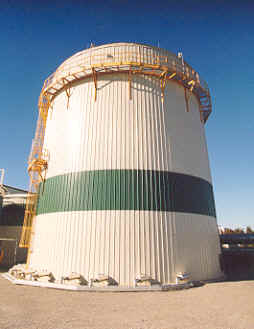
Many fuels can be derived from waste, refuse can be combusted directly in an incinerator to provide power, methane produced at landfill can be collected and combusted, even chicken litter can be dried and combusted. However since this report is looking into biofuels for transport this section will concentrate only on liquid and gas fuels produced from waste that are suitable for combustion in a vehicle engine.
 |
| Used cooking oil perfect for biodiesel |
Biodiesel From Waste Cooking Oils
Every week the UK consumes well in excess of 1,500 tonnes of cooking oil. After using the oil most domestic users simply
pour this waste oil down the sink. (This is actually illegal as waste oil is a listed waste substance.) Large producers of
waste oil such as resteraunts, chipshops and industrial food producers have to have their waste oil removed by licenced
collectors. According to DETR (Department of Environment Transport and Regions, ref2)
esimates there is around 100,000 tonnes of
recoverable waste oil produced each year within the UK. Currently most of this recovered oil is treated and incorparated
back into animal feed, however there is a certain amount of concern regarding this usage indeed the EU has banned its use
for feeding pigs due to several food scares in the vegetable oil and other food sectors. The
EU may also ban its use for feeding cattle too. The result is this oil can be used to produce biodiesel. More details on
what biodiesel is and how it can be produced can be found here.
Currently there are 5 comercial biodiesel producers in the UK.
The waste vegetable oil currently used to produce biodiesel in the UK consists mostly of rapeseed oil, the
transesterification process of rapeseed oil produces RME (Rape Methyle Ester). However there is no guarentee of
the purity of the oil as a proportion will be oil produced from other crops such as sunflower oil or olive oil. As a
result a more correct description would be FAME (Fatty Acid Methyl Ester) which is the correct chemical term for
biodiesel produced from any oil or fat using methanol as the alcohol for the production process.
 |
| Anaerobic Digester producing gas for a power plant in Newmaket, Ontario, Canada |
Anaerobic Digestion (or gasification) is the use of bacteria to decompose organic matter in the absence of oxygen to produce gases .These gases are produced from organic wastes such as livestock manure, food processing waste, etc The end product is a medium heating value biogas mixture (usually 60% methane, 40% carbon dioxide) and a mixture of solid and liquid fertiliser. Because anaerobic digestion does not produce anymore carbon dioxide than would normally be produced from the wastes natural decomposition, it is said to be ‘carbon neutral’
The Process
There are a number of various designs of digester but the same process is usually followed. The digester itself comprises
of an air tight container with an expandable cover to allow gas build up before siphoning. Waste is then pumped regularly
(once a day) into the digester, remaining there for between 10 and 40 days. The temperature inside the digester must be
between 30 and 70 degree Celsius.
Feedstock
Any mixture of organic waste materials may be used such as animal and human sewage, crop residues, newspaper,
abattoir waste, food processing and agricultural waste. The availability of different feedstocks varies due to different
harvest times and also the time of year (e.g. manure collection easier when animals indoors for winter). Therefore,
feedstock mixtures may vary at different times of the year in order to keep the digester active for continuos production.
Since the product in this process is a gas, then generally this fuel is more suited to elecricity generation as opposed to use as a transport fuel. The changes to current infrastructure that would be required to accomadate such a fuel would be difficult at best, though some of the infrastructure does exsist due to the use of compressed natural gas (CNG).
 |
| Scenes like this could be lessened using tyre pyrolysis |
Each day over 100,000 worn tyres are removed from vehicles. This totals around 40 million tyres (440,000 tonnes) per year (The used tyre working group – 25/02/03 ref3). Currently the UK recovers value from around 70% of the total with the balance mostly disposed of in landfills. If by mid-2006 the landfill ban on tyres is going to be adhered to then 100% of the waste tyre resource will have to be recovered. Pyrolysis provided a potential solution to this problem.
The pyrolysis process is the thermal degradation of waste in the absence of oxygen at elevated temperatures and pressures. The process is carried out at temperatures typically upwards of 430°C. In practice, it is not possible to achieve a completely oxygen-free enviroment and so a small amount of oxidation occurs. The products of pyrolysis (from organic waste) are gases, small quantities of liquid, and a solid residue containing carbon and ash. The gases produced in the process can then be used to provide the heating energy for continuing the process.
The tyre pyrolysis process essentially returns the high heating value of the rubber and oils that were initially used in the manufacture of the tyres. By carefully controlling the temperature, pressure and oxygen level more pyrolysis oil and charcoal is encouraged. This pyrolysis oil can then be used as a replacement diesel fuel.
Since the tyres used in the pyrolysis process were originally produced from rubbers and oils extracted from fossil oil then this fuel can not be described as renewable nor can it provide saving on carbon emissions or other green house gases. It does however provide an alternative to landfilling as well as providing other usefull products such as raw tyre pyrolysis carbon, commonly known as ‘carbon black’ which can be combusted or used as a filler.